Diagenetic Classification—A New Concept in the Characterization of Heterogeneous Carbonate Reservoirs: Permian–Triassic Successions in the Persian Gulf
Abstract
1. Introduction
2. Geological Background
3. Materials and Methods
3.1. Dataset
3.2. Petrographic and Petrophysical Methods
3.3. Reservoir Rock Typing and Zonation Methods
3.4. Diagenetic Classification Method
4. Results
4.1. Facies Analysis
4.2. Diagenetic Processes
4.3. Diagenetic Classification
4.3.1. K1 Unit
4.3.2. K2 Unit
4.3.3. K3 Unit
4.3.4. K4 Unit
4.4. Genetical Classification of Pores
4.5. Porosity–Permeability Trends
- (a)
- Fabric-selective dissolution in ooid grainstone facies has resulted in the formation of isolated (oomoldic) pores with high porosity but low permeability. Consequently, a horizontal shift toward higher porosity values was recorded from these samples (marked as A in Figure 10B).
- (b)
- Fabric-destructive dissolution formed large touching vuggy pores within the shoal facies that increased both porosity and permeability (marked as B in Figure 10B).
4.6. Reservoir Quality
4.6.1. Hydraulic Flow Units (HFUs)
4.6.2. Reservoir Characterization Using the Lorenz Plot (SMLP)
5. Discussion
5.1. Paragenesis
5.2. Diagenetic Impact on Reservoir Quality
5.2.1. Diagenetic Processes Enhancing Reservoir Quality
- (a)
- Fabric-selective dissolution of aragonitic allochems (mainly ooids) that forms substantial moldic and separate vuggy porosity (isolated pores) but does not significantly increase permeability. High porosity (up to 35%) and low to moderate permeability values (0.1–1 mD) were recorded from samples in which fabric-selective (moldic) dissolution was predominant.
- (b)
- Non-fabric selective dissolution of high-energy facies that leads to the development of touching (interconnected) vuggy porosity. It resulted in high porosity (up to 30%) and permeability (1 to 100 mD) (Figure 10).
5.2.2. Diagenetic Processes Reducing Reservoir Quality
5.2.3. Diagenetic Processes with a Minimal or Unknown Impact on Reservoir Quality
6. Conclusions
Author Contributions
Funding
Data Availability Statement
Acknowledgments
Conflicts of Interest
References
- Ahr, W.M. Geology of Carbonate Reservoirs; Wiley: Hoboken, NJ, USA, 2008. [Google Scholar] [CrossRef]
- Tavakoli, V. Carbonate Reservoir Heterogeneity; Springer: Cham, Switzerland, 2020. [Google Scholar] [CrossRef]
- Isah, A.; Arif, M.; Hassan, A.; Mahmoud, M.; Iglauer, S. Fluid–rock interactions and its implications on EOR: Critical analysis, experimental techniques and knowledge gaps. Energy Rep. 2022, 8, 6355–6395. [Google Scholar] [CrossRef]
- Ozotta, O.; Saberi, M.R.; Kolawole, O.; Malki, M.L.; Rasouli, V.; Pu, H. Pore morphology effect on elastic and fluid flow properties in Bakken formation using rock physics modeling. Geomech. Geophys. Geo-Energy Geo-Resour. 2022, 8, 210. [Google Scholar] [CrossRef]
- Shalaby, M.R.; Thota, S.T.; Norsahminan, D.N.P.; Kamalrulzaman, K.N.; Matter, W.S.; Al-Awah, H. Reservoir quality evaluation using petrophysical, well-log analysis and petrographical description: A case study from the Carboniferous–Permian Kulshill group formations, southern Bonaparte Basin, Australia. Geoenergy Sci. Eng. 2023, 226, 211738. [Google Scholar] [CrossRef]
- Pathania, T.; Bottacin-Busolin, A.; Eldho, T.I. Evaluating the effect of aquifer heterogeneity on multiobjective optimization of in-situ groundwater bioremediation. Eng. Anal. Bound. Elem. 2023, 148, 336–350. [Google Scholar] [CrossRef]
- Mehrabi, H. Deposition, diagenesis, and geochemistry of Upper Cretaceous carbonates (Sarvak Formation) in the Zagros Basin and the Persian Gulf, Iran. Minerals 2023, 13, 1078. [Google Scholar] [CrossRef]
- Lai, J.; Wang, G.; Chai, Y.; Ran, Y.; Zhang, X. Depositional and diagenetic controls on pore structure of tight gas sandstone reservoirs: Evidence from Lower Cretaceous Bashijiqike Formation in Kelasu Thrust Belts, Kuqa Depression in Tarim Basin of West China. Resour. Geol. 2015, 65, 55–75. [Google Scholar] [CrossRef]
- Overare, B.; Azmy, K.; Garzanti, E.; Avwenagha, E.O.; Emudianughe, J.E. Diagenetic imprints in the reservoirs of Agbada Formation, Niger Delta Basin: Implication for reservoir quality and appraisal of calcite cement. Mar. Pet. Geol. 2024, 163, 106746. [Google Scholar] [CrossRef]
- Shang, T.; Chu, M.; Zhang, X.; Wang, B.; Li, J.; Zhang, H.; Zhang, Z.; Liu, X. Quantitative analysis of pore evolution and its application in basin simulation: A case study of Chang 6 reservoir in Heshui area, Ordos Basin, NW China. Energy Geosci. 2025, 6, 100403. [Google Scholar] [CrossRef]
- Tavoosi Iraj, P.; Mehrabi, H.; Rahimpour-Bonab, H.; Ranjbar-Karami, R. Quantitative analysis of geological attributes for reservoir heterogeneity assessment in carbonate sequences; a case from Permian–Triassic reservoirs of the Persian Gulf. J. Pet. Sci. Eng. 2021, 200, 108356. [Google Scholar] [CrossRef]
- Foroshani, J.S.; Mehrabi, H.; Rahimpour-Bonab, H. Reservoir heterogeneity of Upper Cretaceous Sarvak Formation in the Dezful Embayment, SW Iran: Implications of flow unit distribution, electrofacies analysis and geological-based reservoir zonation. J. Afr. Earth Sci. 2023, 200, 104882. [Google Scholar] [CrossRef]
- Jafarian, A.; Kakemem, U.; Husinec, A.; Mehrabi, H.; Javanbakht, M.; Wang, C.; Chen, X.; Li, Y. Depositional facies and diagenetic control on reservoir quality of the Aptian Dariyan Formation, NW Persian Gulf. Mar. Pet. Geol. 2024, 165, 106895. [Google Scholar] [CrossRef]
- Jafarian, A.; Kakemem, U.; Husinec, A.; Mehrabi, H.; Pouyafard, Z.; Ghasemi, M.; Senemari, S.; Saboor, A.; Wang, C. Syn- and post-depositional influences on reservoir quality of the Aptian Dariyan Formation, eastern Persian Gulf. Pet. Geosci. 2025, in press. [Google Scholar] [CrossRef]
- Lai, J.; Su, Y.; Xiao, L.; Zhao, F.; Bai, T.; Li, Y.; Li, H.; Huang, Y.; Wang, G.; Qin, Z. Application of geophysical well logs in solving geologic issues: Past, present and future prospect. Geosci. Front. 2024, 15, 101779. [Google Scholar] [CrossRef]
- Zhang, B.; Liang, Y.; Wang, P.; Yeh, T.J.; Dai, L.; Xia, R.; Zhang, H.; Xu, B.; Zhang, S. Incorporating electrical sounding survey into geostatistical electrical resistivity tomography for high-resolution characterization of karst aquifer. J. Hydrol. 2025, 656, 133018. [Google Scholar] [CrossRef]
- Lis-Śledziona, A. Petrophysical rock typing and permeability prediction in tight sandstone reservoir. Acta Geophys. 2019, 67, 1895–1911. [Google Scholar] [CrossRef]
- Metawee, M.; Araffa, S.A.S.; Othman, A.; Alfy, M.E. Geophysical and geospatial insights into surface and subsurface characteristics for groundwater potential analysis, Ras Sudr, West Sinai, Egypt. Environ. Earth Sci. 2024, 83, 616. [Google Scholar] [CrossRef]
- Tavakoli, V. Core analysis: An introduction. In Core Analysis; Springer: Cham, Switzerland, 2018; pp. 1–13. [Google Scholar] [CrossRef]
- Rashid, F.; Hussein, D.; Glover, P.W.J.; Lorinczi, P.; Lawrence, J.A. Quantitative diagenesis: Methods for studying the evolution of the physical properties of tight carbonate reservoir rocks. Mar. Pet. Geol. 2022, 139, 105603. [Google Scholar] [CrossRef]
- Bukar, M.; Worden, R.H.; Bukar, S.; Shell, P. Diagenesis and its controls on reservoir quality of the Tambar oil field, Norwegian North Sea. Energy Geosci. 2021, 2, 10–31. [Google Scholar] [CrossRef]
- Worden, R.H.; Armitage, P.J.; Butcher, A.R.; Churchill, J.M.; Csoma, A.E.; Hollis, C.; Lander, R.H.; Omma, J.E. Petroleum reservoir quality prediction: Overview and contrasting approaches from sandstone and carbonate communities. Geol. Soc. Lond. Spec. Publ. 2018, 435, 1–31. [Google Scholar] [CrossRef]
- Mehrabi, H.; Yahyaei, E.; Navidtalab, A.; Rahimpour-Bonab, H.; Abbasi, R.; Omidvar, M.; Assadi, A.; Honarmand, J. Depositional and diagenetic controls on reservoir properties along the shallow-marine carbonates of the Sarvak Formation, Zagros Basin: Petrographic, petrophysical, and geochemical evidence. Sediment. Geol. 2023, 454, 106457. [Google Scholar] [CrossRef]
- Mehrabi, H.; Fakhar-Shahreza, N.; Karami, F.; Honarmand, J. Controls of tectonics and paleoclimate on depositional–diagenetic evolution and pore types of Upper Cretaceous successions (Sarvak Formation) in the Abadan plain, Iran. Mar. Pet. Geol. 2024, 170, 107118. [Google Scholar] [CrossRef]
- Abbasi, R.; Mehrabi, H.; Yahyaei, E.; Rahimpour-Bonab, H. Diagenetic evolution of Upper Cretaceous carbonate sequences (Sarvak Formation) in the Abadan Plain, Iran: Evidence from petrographic, elemental, stable, and strontium isotopic data. Int. Geol. Rev. 2024, 66, 3793–3813. [Google Scholar] [CrossRef]
- Rabbani, A.R.; Kotarba, M.J.; Baniasad, A.R.; Hosseiny, E.; Wieclaw, D. Geochemical characteristics and genetic types of the crude oils from the Iranian sector of the Persian Gulf. Org. Geochem. 2014, 70, 29–43. [Google Scholar] [CrossRef]
- Orang, K.; Motamedi, H.; Azadikhah, A.; Royatvand, M. Structural framework and tectono-stratigraphic evolution of the eastern Persian Gulf, offshore Iran. Mar. Pet. Geol. 2018, 91, 89–107. [Google Scholar] [CrossRef]
- Ziegler, A.M. Late Permian to Holocene Paleofacies Evolution of the Arabian Plate and its Hydrocarbon Occurrences. GeoArabia 2001, 6, 445–504. [Google Scholar] [CrossRef]
- Insalaco, E.; Virgone, A.; Courme, B.; Gaillot, J.; Kamali, M.; Moallemi, A.; Lotfpour, M.; Monibi, S. Upper Dalan Member and Kangan Formation between the Zagros Mountains and offshore Fars, Iran: Depositional system, biostratigraphy and stratigraphic architecture. GeoArabia 2006, 11, 75–176. [Google Scholar] [CrossRef]
- Kakemem, U.; Ghasemi, M.; Adabi, M.H.; Husinec, A.; Mahmoudi, A.; Anderskouv, K. Sedimentology and sequence stratigraphy of automated hydraulic flow units—The Permian Upper Dalan Formation, Persian Gulf. Mar. Pet. Geol. 2023, 147, 105965. [Google Scholar] [CrossRef]
- Tavakoli, V.; Barfizadeh, H. The role of plate movements on reservoir development of the Iranian carbonate formations: A review of the interplay between tectonics, paleoclimate, and diagenesis. Results Earth Sci. 2024, 2, 100037. [Google Scholar] [CrossRef]
- Mehrabi, H.; Rahimpour-Bonab, H.; Enayati, A.; Esrafili-Dizaji, B. Impact of contrasting paleoclimate on carbonate reservoir architecture: Cases from arid Permo-Triassic and humid Cretaceous platforms in the south and southwestern Iran. J. Pet. Sci. Eng. 2015, 126, 262–283. [Google Scholar] [CrossRef]
- Esrafili-Dizaji, B.; Rahimpour-Bonab, H. Carbonate reservoir rocks at giant oil and gas fields in SW Iran and the adjacent offshore: A review of stratigraphic occurrence and poro-perm characteristics. J. Pet. Geol. 2019, 42, 343–370. [Google Scholar] [CrossRef]
- Perotti, C.R.; Carruba, S.; Rinaldi, M.; Bertozzi, G.; Feltre, L.; Rahimi, M. The Qatar–South Fars Arch Development (Arabian Platform, Persian Gulf): Insights from Seismic Interpretation and Analogue Modelling. In New Frontiers in Tectonic Research—At the Midst of Plate Convergence; InTech: Rijeka, Croatia, 2011. [Google Scholar] [CrossRef]
- Esrafili-Dizaji, B.; Rahimpour-Bonab, H. A review of Permo-Triassic reservoir rocks in the Zagros area, SW Iran: Influence of the Qatar-Fars arch. J. Pet. Geol. 2013, 36, 257–279. [Google Scholar] [CrossRef]
- Vail, P.R.; Mitchum, R.M.; Thompson, S. Seismic stratigraphy and global changes of sea level, parts 3 and 4. In Seismic Stratigraphy—Applications to Hydrocarbon Exploration; Payton, C.E., Ed.; AAPG Memoir 26; American Association of Petroleum Geologists: Tulsa, OK, USA, 1977; pp. 63–97. [Google Scholar]
- Kiessling, W.; Flügel, E.; Golonka, J. (Eds.) Phanerozoic Reef Patterns; SEPM Special Publication No. 72; Society for Sedimentary Geology (SEPM): Tulsa, OK, USA, 2002; 775p. [Google Scholar] [CrossRef]
- Bots, P.; Benning, L.G.; Rickaby, R.E.M.; Shaw, S. The role of SO4 in the switch from calcite to aragonite seas. Geology 2011, 39, 331–334. [Google Scholar] [CrossRef]
- Jafarian, A.; Fallah-Bagtash, R.; Mattern, F.; Heubeck, C. Reservoir quality along a homoclinal carbonate ramp deposit: The Permian Upper Dalan Formation, South Pars Field, Persian Gulf Basin. Mar. Pet. Geol. 2017, 88, 587–604. [Google Scholar] [CrossRef]
- Heydari, E.; Arzani, N.; Safaei, M.; Hassanzadeh, J. Ocean’s response to a changing climate: Clues from variations in carbonate mineralogy across the Permian–Triassic boundary of the Shareza Section, Iran. Glob. Planet. Change 2013, 105, 79–90. [Google Scholar] [CrossRef]
- Fallah-Bagtash, R.; Jafarian, A.; Husinec, A.; Adabi, M.H. Diagenetic stabilization of the Upper Permian Dalan Formation, Persian Gulf Basin. J. Asian Earth Sci. 2020, 189, 104144. [Google Scholar] [CrossRef]
- Bourquin, S.; Bercovici, A.; López-Gómez, J.; Diez, J.B.; Broutin, J.; Ronchi, A.; Durand, M.; Arché, A.; Linol, B.; Amour, F. The Permian–Triassic transition and the onset of Mesozoic sedimentation at the northwestern peri-Tethyan domain scale: Palaeogeographic maps and geodynamic implications. Palaeogeogr. Palaeoclimatol. Palaeoecol. 2011, 299, 265–280. [Google Scholar] [CrossRef]
- Viaretti, M.; Crippa, G.; Brombin, V.; della Porta, G.; Griesshaber, E.; Jurikova, H.; Posenato, R.; Bottini, C.; Angiolini, L. Duration and intensity of the Late Permian (early Wuchiapingian) cool climate episode: Sclerochemical evidence from brachiopod assemblages in Iran. Palaeogeogr. Palaeoclimatol. Palaeoecol. 2025, 659, 112654. [Google Scholar] [CrossRef]
- Gibbs, M.T.; Rees, P.M.; Kutzbach, J.E.; Ziegler, A.M.; Behling, P.J.; Rowley, D.B. Simulations of Permian Climate and Comparisons with Climate-Sensitive Sediments. J. Geol. 2002, 110, 33–55. [Google Scholar] [CrossRef]
- Parrish, J.T. Climate of the supercontinent Pangea. J. Geol. 1993, 101, 215–233. [Google Scholar] [CrossRef]
- Winguth, A.M.E.; Shields, C.A.; Winguth, C. Transition into a Hothouse World at the Permian–Triassic boundary—A model study. Palaeogeogr. Palaeoclimatol. Palaeoecol. 2015, 440, 316–327. [Google Scholar] [CrossRef]
- Davydov, V.I.; Karasev, E.V.; Nurgalieva, N.G.; Schmitz, M.D.; Budnikov, I.V.; Biakov, A.S.; Kuzina, D.M.; Silantiev, V.V.; Urazaeva, M.N.; Zharinova, V.V.; et al. Climate and biotic evolution during the Permian-Triassic transition in the temperate Northern Hemisphere, Kuznetsk Basin, Siberia, Russia. Palaeogeogr. Palaeoclimatol. Palaeoecol. 2021, 573, 110432. [Google Scholar] [CrossRef]
- Konert, G.; Afifi, A.; Al-Hajri, S.; Droste, H. Paleozoic Stratigraphy and Hydrocarbon Habitat of the Arabian Plate. Geoarabia 2001, 6, 407–442. [Google Scholar] [CrossRef]
- Lashin, A.; AlQuraishi, A.A.; AlKhidir, K.; Kinawy, M.M.; al Jawder, A. Characterization of the Permo-Triassic upper Khuff reservoir, central Saudi Arabia: An integrated core plugs, petro-fabrics and mercury injection analysis. J. Afr. Earth Sci. 2018, 145, 284–296. [Google Scholar] [CrossRef]
- Esrafili-Dizaji, B.; Rahimpour-Bonab, H. Effects of depositional and diagenetic characteristics on carbonate reservoir quality: A case study from the South Pars gas field in the Persian Gulf. Petrol. Geosci. 2009, 15, 325–344. [Google Scholar] [CrossRef]
- Embry, A.F. Transgressive-Regressive (T-R) Sequence Stratigraphy. In Sequence Stratigraphic Models for Exploration and Production: Evolving Methodology, Emerging Models and Application Histories; Armentrout, J.M., Rosen, N.C., Eds.; SEPM Society for Sedimentary Geology: Claremore, OK, USA, 2002. [Google Scholar]
- Amaefule, J.-O.; Altunbay, M.; Tiab, J.; Kersey, D.-G.; Keelan, D.-K. Enhanced reservoir description: Using core and log data to identify hydraulic (flow) units and predict permeability in uncored intervals/wells. In Proceedings of the Society of Petroleum Engineers, Oklahoma City, OK, USA, 21–23 March 1993. [Google Scholar] [CrossRef]
- Gunter, G.W.; Finneran, J.M.; Hartmann, D.J.; Miller, J.D. Early determination of reservoir flow units using an integrated petrophysical method. In Proceedings of the SPE Annual Technical Conference and Exhibition, San Antonio, TX, USA, 5–8 October 1997. [Google Scholar] [CrossRef]
- Kopaska-Merkel, D.; Mann, S. Classification of lithified carbonates using ternary plots of pore facies: Examples from the Jurassic Smackover Formation. In Carbonate Microfabrics; Springer: Boston, MA, USA, 1993; pp. 265–277. [Google Scholar] [CrossRef]
- Tavakoli, V.; Rahimpour-Bonab, H.; Esrafili-Dizaji, B. Diagenetic controlled reservoir quality of South Pars gas field, an integrated approach. Comptes Rendus Geosci. 2011, 343, 55–71. [Google Scholar] [CrossRef]
- Amel, H.; Jafarian, A.; Husinec, A.; Koeshidayatullah, A.; Swennen, R. Microfacies, depositional environment and diagenetic evolution controls on the reservoir quality of the Permian Upper Dalan Formation, Kish Gas Field, Zagros Basin. Mar. Petrol. Geol. 2015, 67, 57–71. [Google Scholar] [CrossRef]
- Kakemem, U.; Jafarian, A.; Husinec, A.; Adabi, M.H.; Mahmoudi, A. Facies, sequence framework, and reservoir quality along a Triassic carbonate ramp: Kangan Formation, South Pars Field, Persian Gulf Superbasin. J. Pet. Sci. Eng. 2021, 198, 108166. [Google Scholar] [CrossRef]
- Enayati-Bidgoli, A.H.; Rahimpour-Bonab, H.; Mehrabi, H. Flow unit characterisation in the Permian-Triassic carbonate reservoir succession at South Pars Gas Field, Offshore Iran. J. Pet. Geol. 2014, 37, 205–230. [Google Scholar] [CrossRef]
- Mehrabi, H.; Mansouri, M.; Rahimpour-Bonab, H.; Tavakoli, V.; Hassanzadeh, M. Chemical compaction features as potential barriers in the Permian-Triassic reservoirs of Southern Iran. J. Pet. Sci. Eng. 2016, 145, 95–113. [Google Scholar] [CrossRef]
- Enayati-Bidgoli, A.H.; Rahimpour-Bonab, H. A geological based reservoir zonation scheme in a sequence stratigraphic framework: A case study from the Permo-Triassic gas reservoirs, Offshore Iran. Mar. Petrol. Geol. 2016, 73, 36–58. [Google Scholar] [CrossRef]
- Messadi, A.M.; Mardassi, B.; Ouali, J.A.; Touir, J. Sedimentology, diagenesis, clay mineralogy and sequential analysis model of Upper Paleocene evaporite-carbonate ramp succession from Tamerza area (Gafsa Basin: Southern Tunisia). J. Afr. Earth Sci. 2016, 118, 205–230. [Google Scholar] [CrossRef]
- Machel, H. Concepts and models of dolomitization: A critical reappraisal. Geol. Soc. Lond. Spec. Publ. 2004, 235, 7–63. [Google Scholar] [CrossRef]
- Mehrabi, H.; Pouyafard, Z.; Bahrehvar, M.; Al-Aasm, I.S. Diverse dolomitization models in the Aptian Dariyan (Shu’aiba) Formation in the Persian Gulf, Iran: Evidence from petrography, geochemistry and impact on reservoir quality. Mar. Petrol. Geol. 2025, 172, 107229. [Google Scholar] [CrossRef]
- Moore, C.H. Carbonate Reservoirs: Porosity Evolution and Diagenesis in a Sequence Stratigraphic Framework; Elsevier: Amsterdam, The Netherlands, 2001. [Google Scholar]
- Saller, A.H. Paleozoic dolomite reservoirs in the Permian Basin, SW USA: Stratigraphic distribution, porosity, permeability and production. Geol. Soc. Lond. Spec. Publ. 2004, 235, 309–323. [Google Scholar] [CrossRef]
- Croizé, D.; Renard, F.; Gratier, J.-P. Compaction and porosity reduction in carbonates: A review of observations, theory, and experiments. In Advances in Carbonate Sedimentology; Elsevier: Amsterdam, The Netherlands, 2013; pp. 181–238. [Google Scholar] [CrossRef]
- Mohammed Sajed, O.K.; Glover, P.W.J. Dolomitisation, cementation and reservoir quality in three Jurassic and Cretaceous carbonate reservoirs in north-western Iraq. Mar. Petrol. Geol. 2020, 115, 104256. [Google Scholar] [CrossRef]
- Afroogh, A.; Mehrabi, H. How geomechanical attributes control the morphology of stylolites in carbonate sequences? A case from Permian–Triassic gas reservoirs in the Persian Gulf. Geomech. Energy Environ. 2023, 33, 100424. [Google Scholar] [CrossRef]
- Heap, M.J.; Baud, P.; Reuschlé, T.; Meredith, P. Stylolites in limestones: Barriers to fluid flow? Geology 2013, 42, 51–54. [Google Scholar] [CrossRef]
- Toussaint, R.; Aharonov, E.; Koehn, D.; Gratier, J.-P.; Ebner, M.; Baud, P.; Rolland, A.; Renard, F. Stylolites: A review. J. Struct. Geol. 2018, 114, 163–195. [Google Scholar] [CrossRef]
- Bahrehvar, M.; Mehrabi, H.; Akbarzadeh, S.; Rahimpour-Bonab, H. Depositional and diagenetic controls on reservoir quality of the uppermost Jurassic–Lower Cretaceous sequences in the Persian Gulf; a focus on J–K boundary. J. Pet. Sci. Eng. 2021, 201, 108512. [Google Scholar] [CrossRef]
- Garuglieri, E.; Marasco, R.; Odobel, C.; Chandra, V.; Teillet, T.; Areias, C.; Sánchez-Román, M.; Vahrenkamp, V.; Daffonchio, D. Searching for microbial contribution to micritization of shallow marine sediments. Environ. Microbiol. 2024, 26, e16573. [Google Scholar] [CrossRef]
- Wadood, B.; Khan, S.; Wagreich, M.; Vennemann, T.; Li, H.; Ullah, M.; Schöpfer, K. Diagenetic history and porosity evolution of the Middle Permian clastic-carbonate mixed system, Indus Basin, Pakistan: Implications for reservoir development. Energy Geosci. 2024, 5, 100317. [Google Scholar] [CrossRef]
- Lau, K.V.; Hardisty, D.S. Modeling the impacts of diagenesis on carbonate paleoredox proxies. Geochim. Cosmochim. Acta 2022, 337, 123–139. [Google Scholar] [CrossRef]
- Blinkenberg, K.H.; Rameil, N.; Hodgskiss, M.S.W.; Polonio, I.; Riber, L.; Gianotten, I.P.; Roberts, N.M.W.; Lepland, A.; Stemmerik, L. Widespread dolomite recrystallization and porosity modification of upper Permian Zechstein carbonates, Symra discovery, Utsira High, Norwegian North Sea. Mar. Petrol. Geol. 2024, 170, 107064. [Google Scholar] [CrossRef]
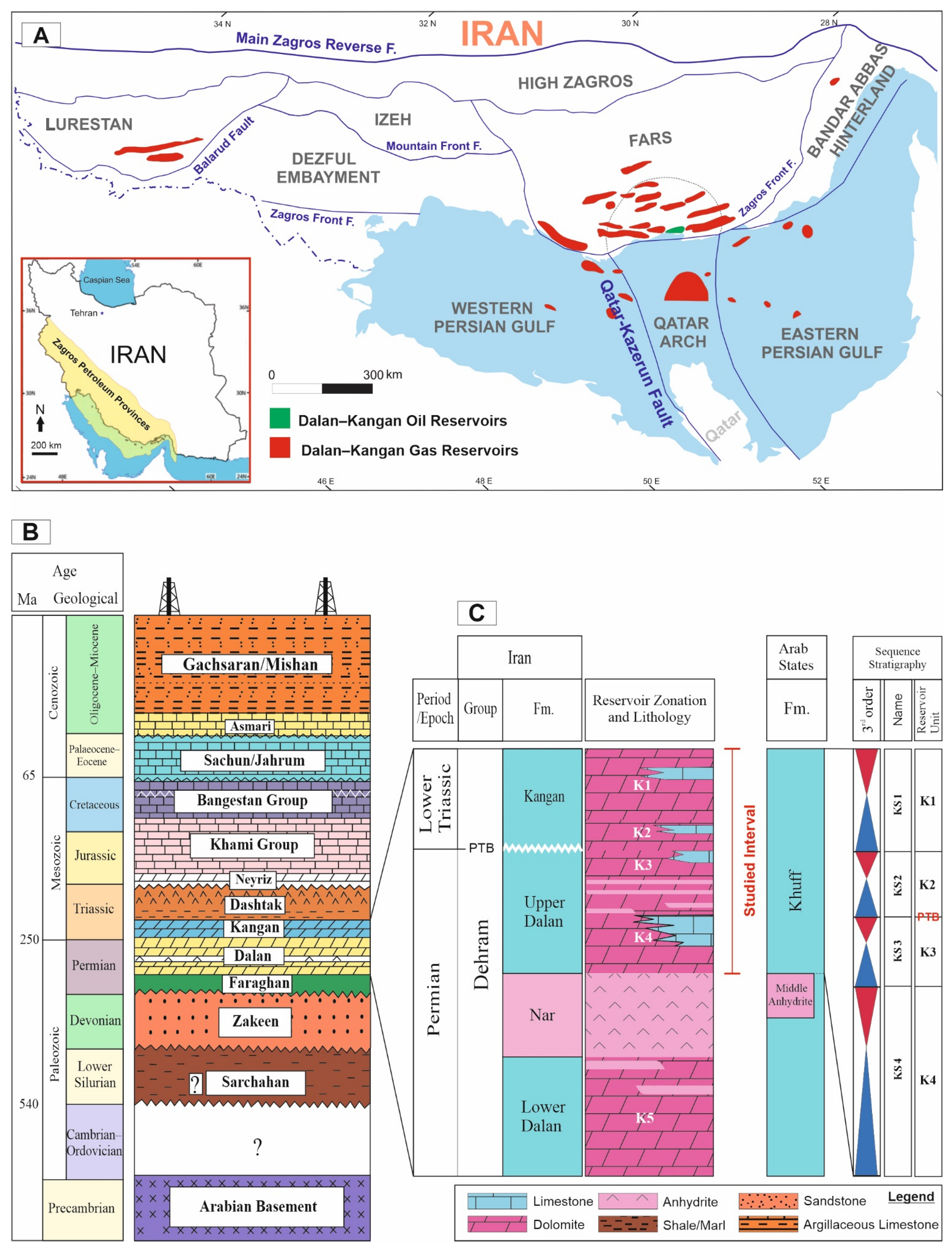

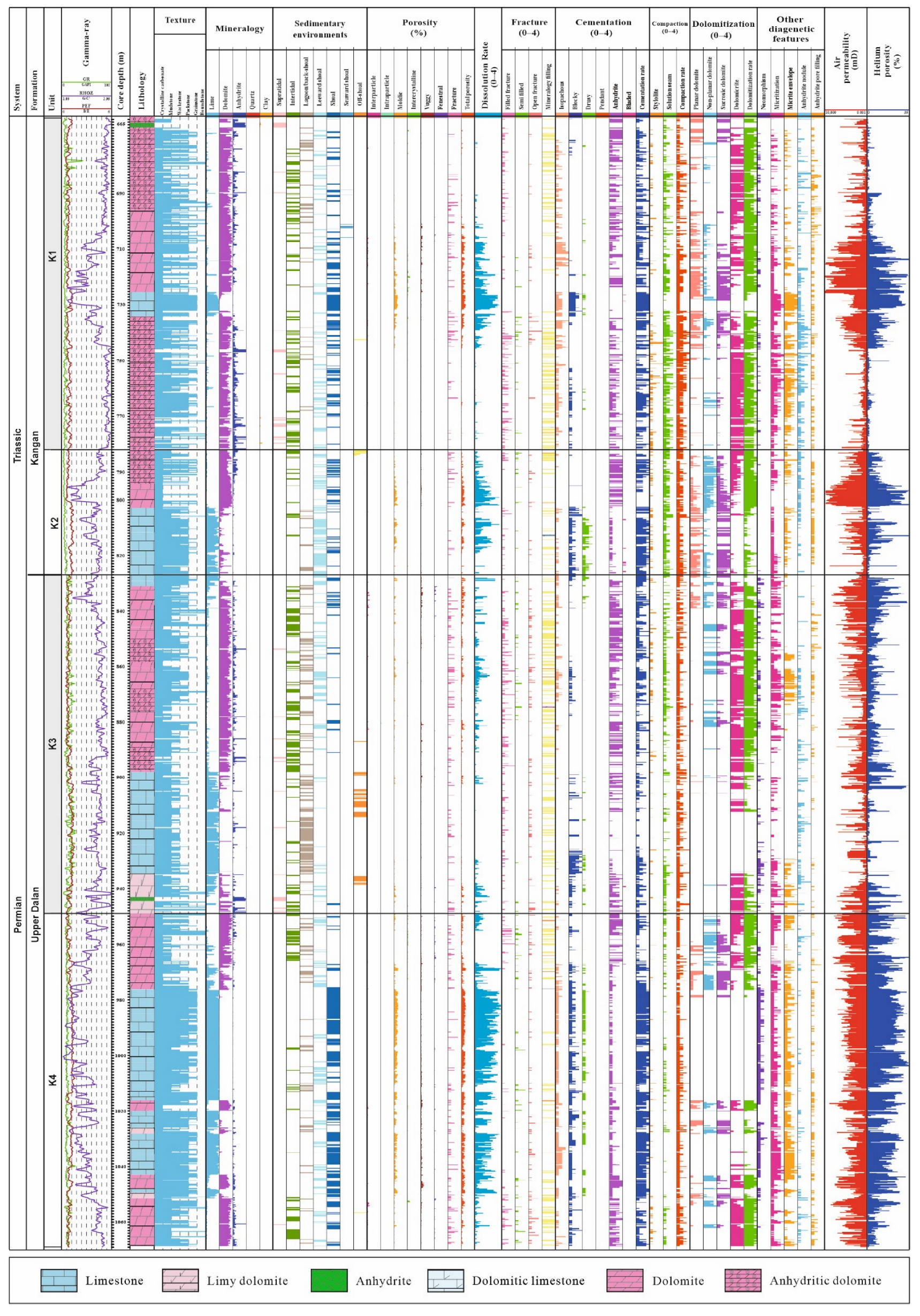
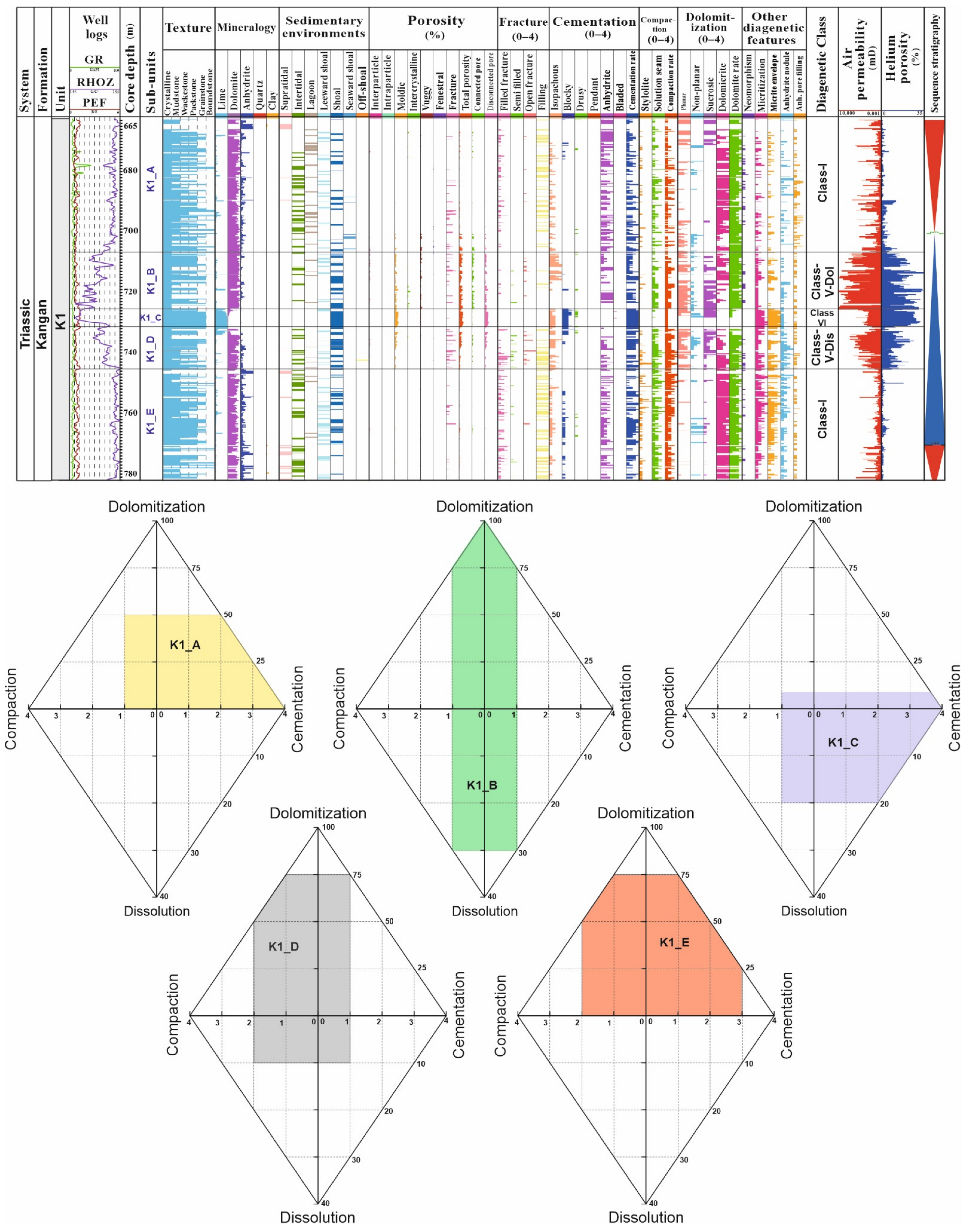
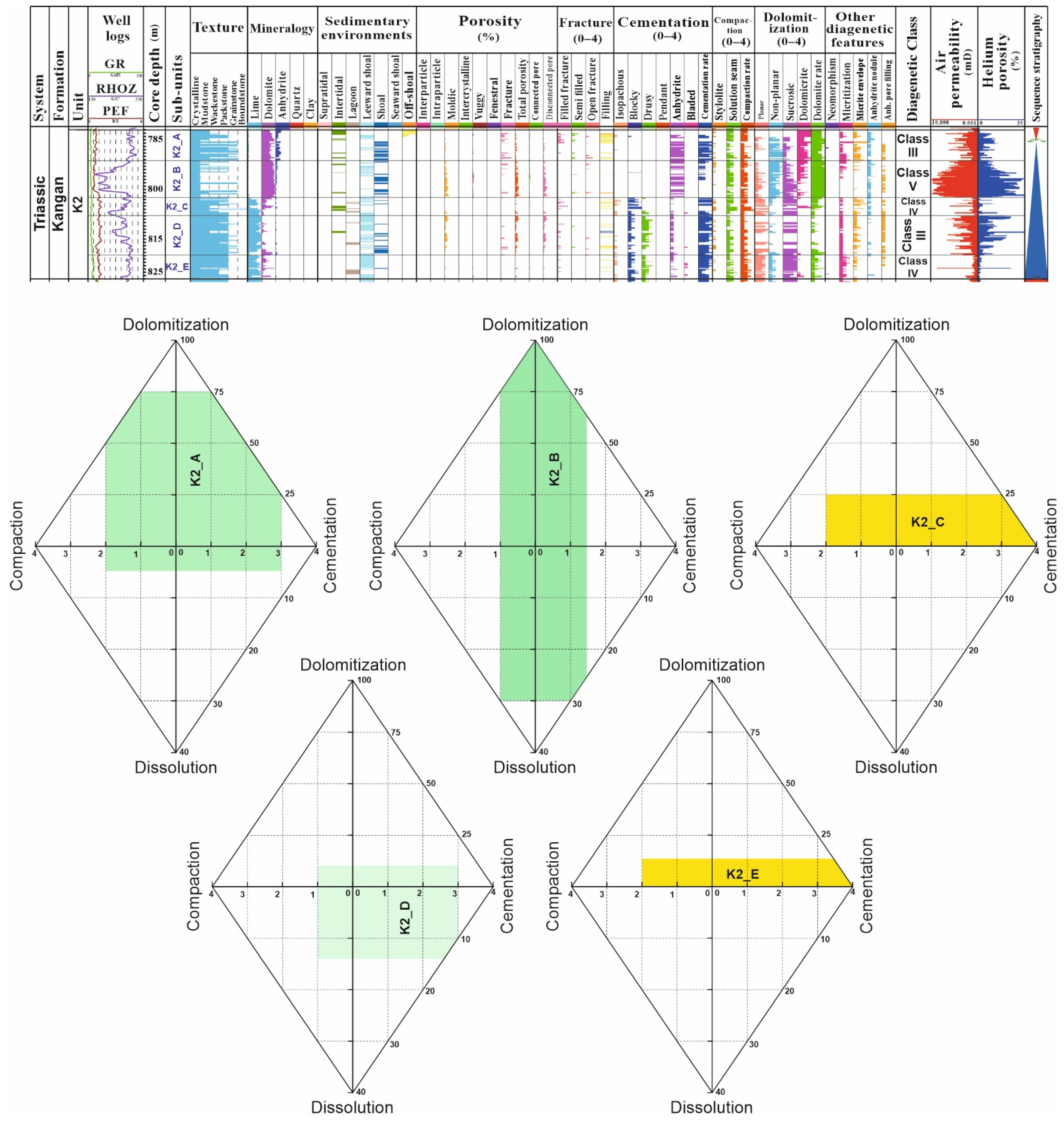

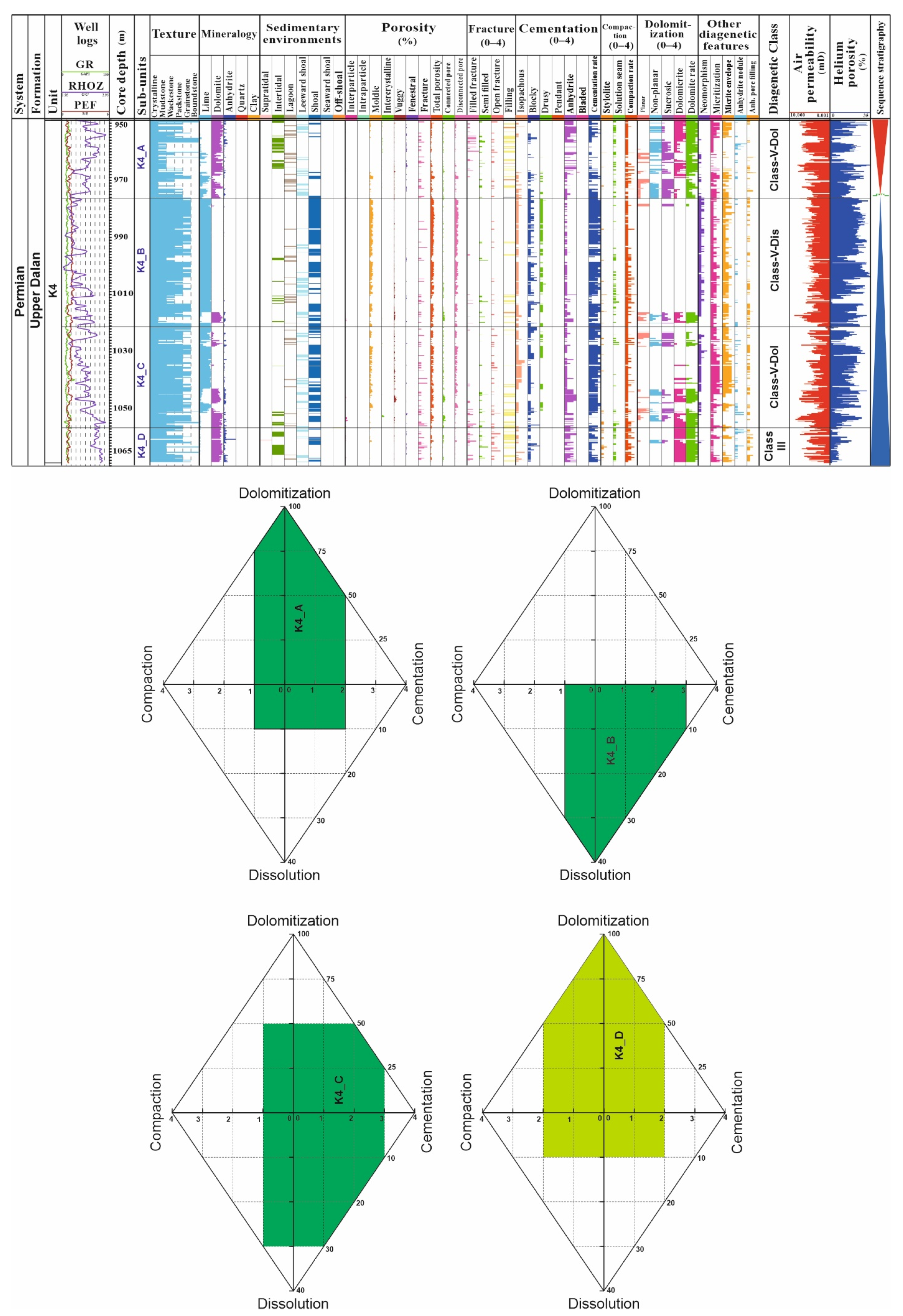
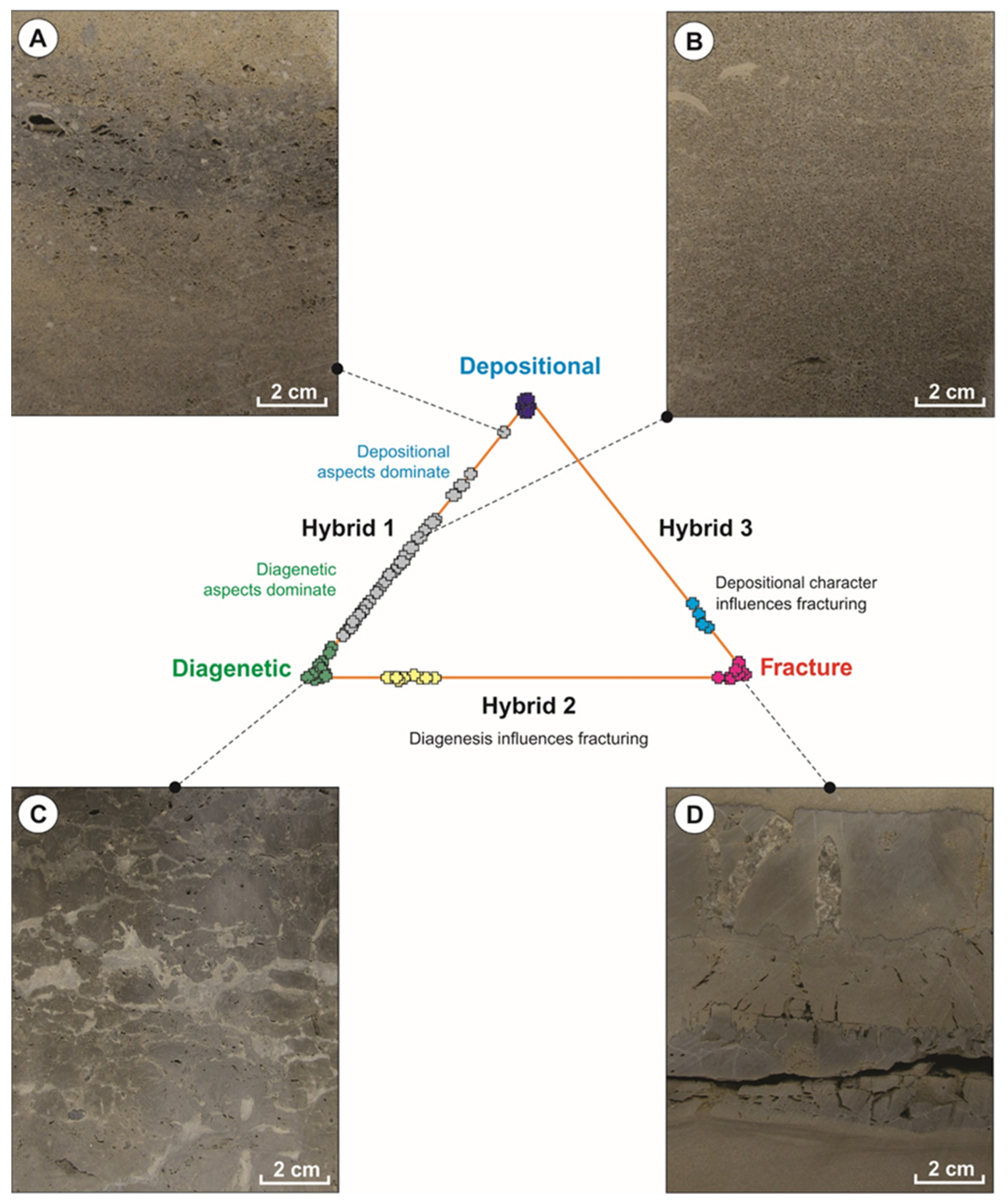
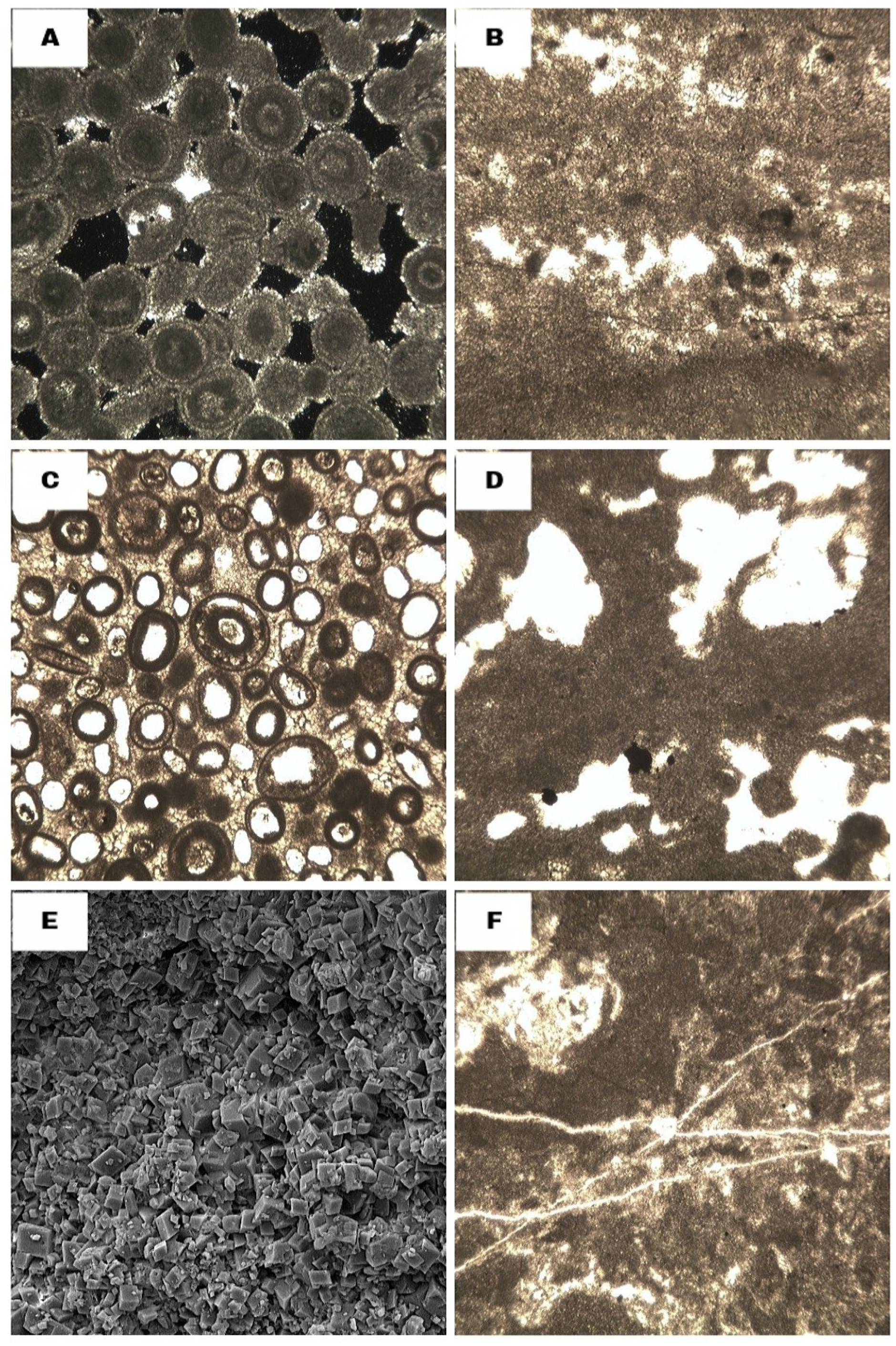
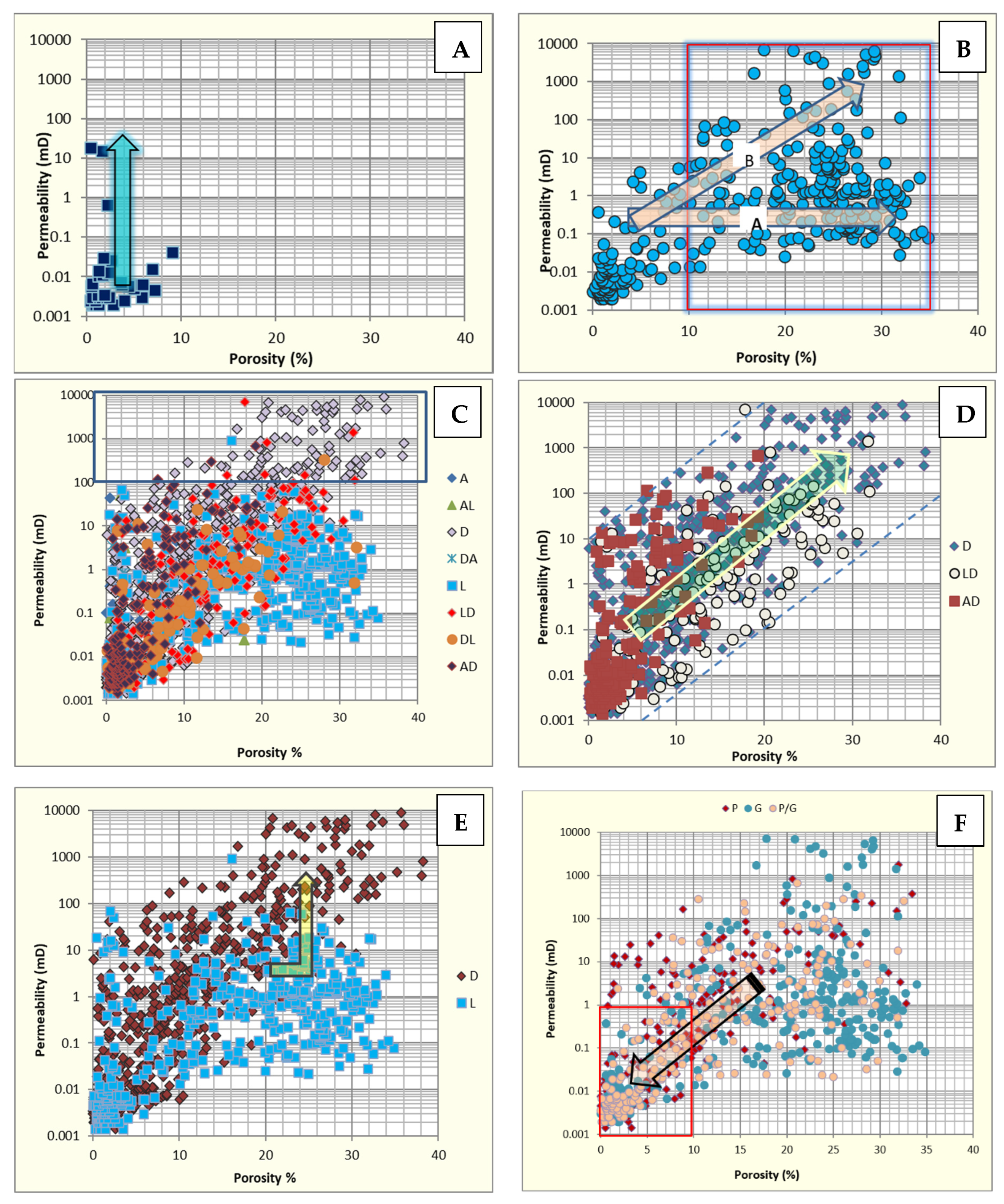
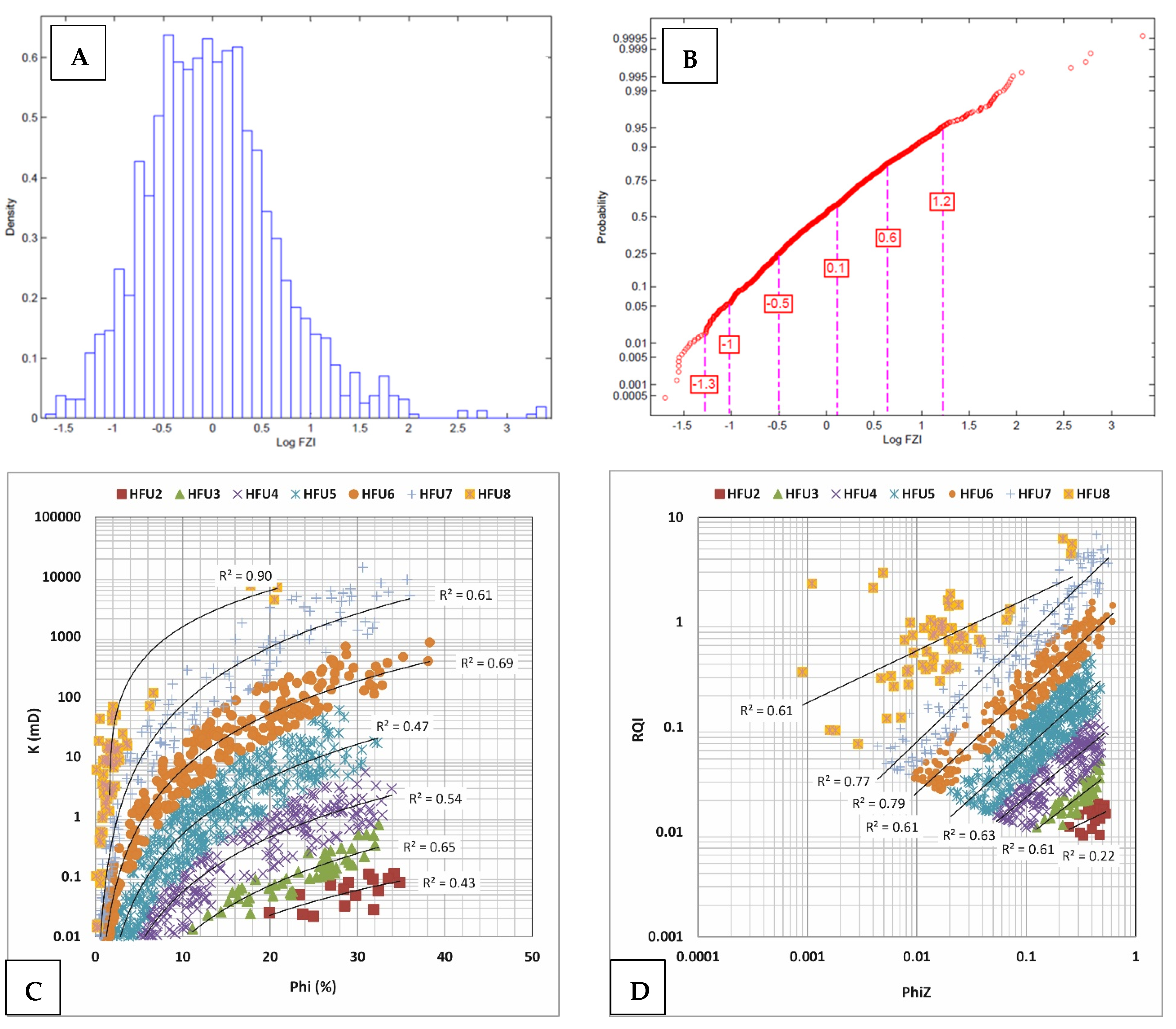

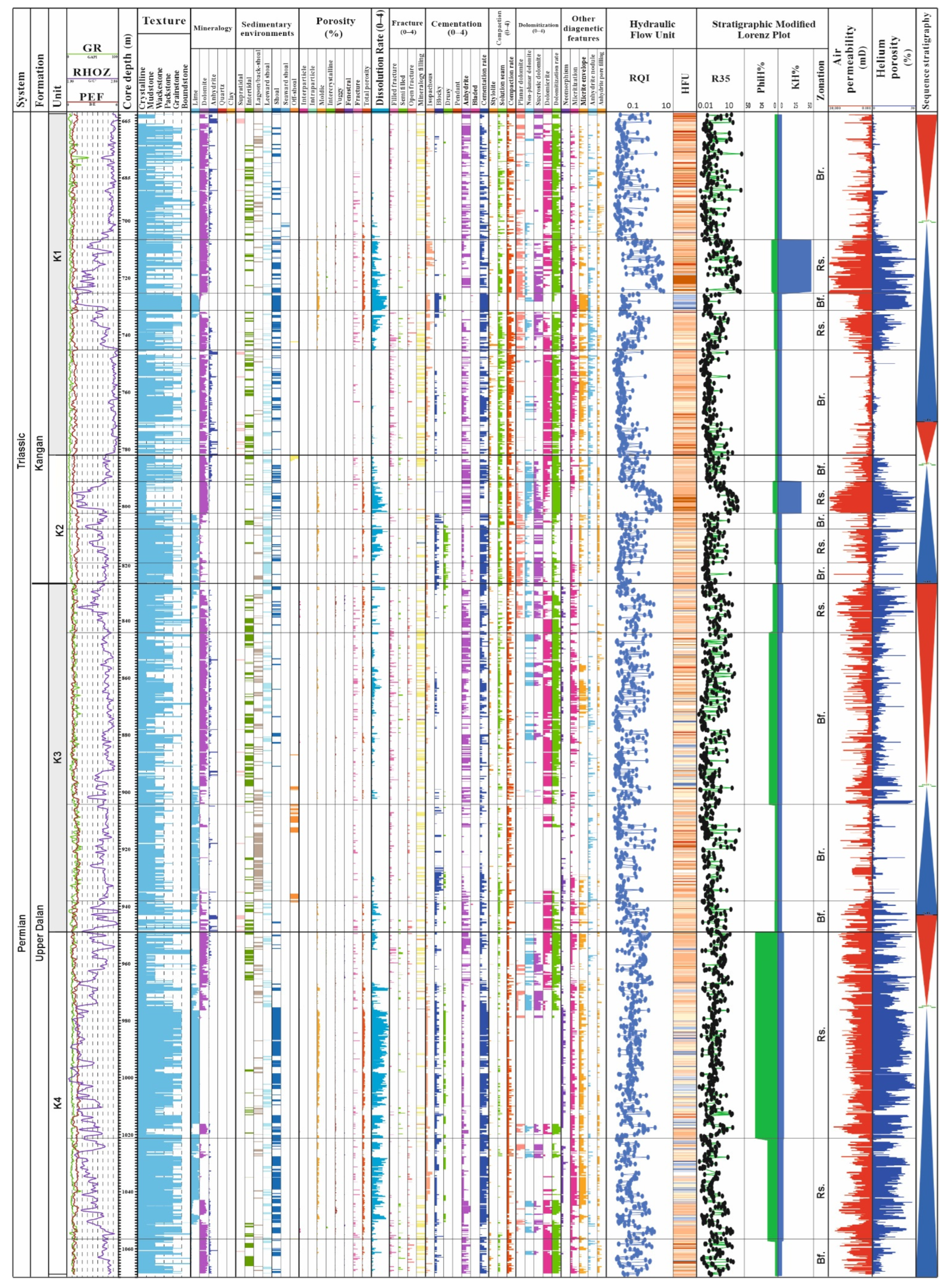
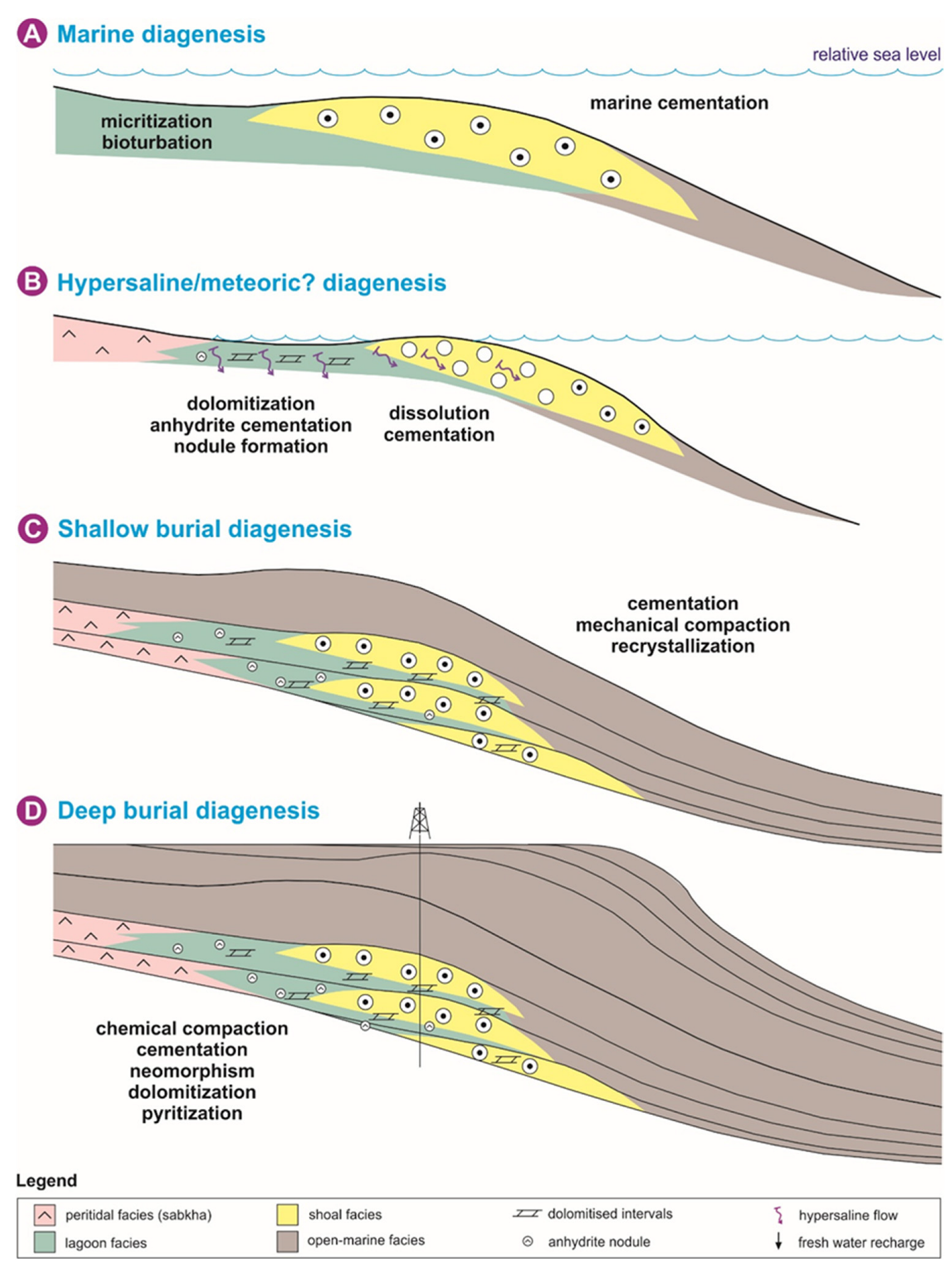
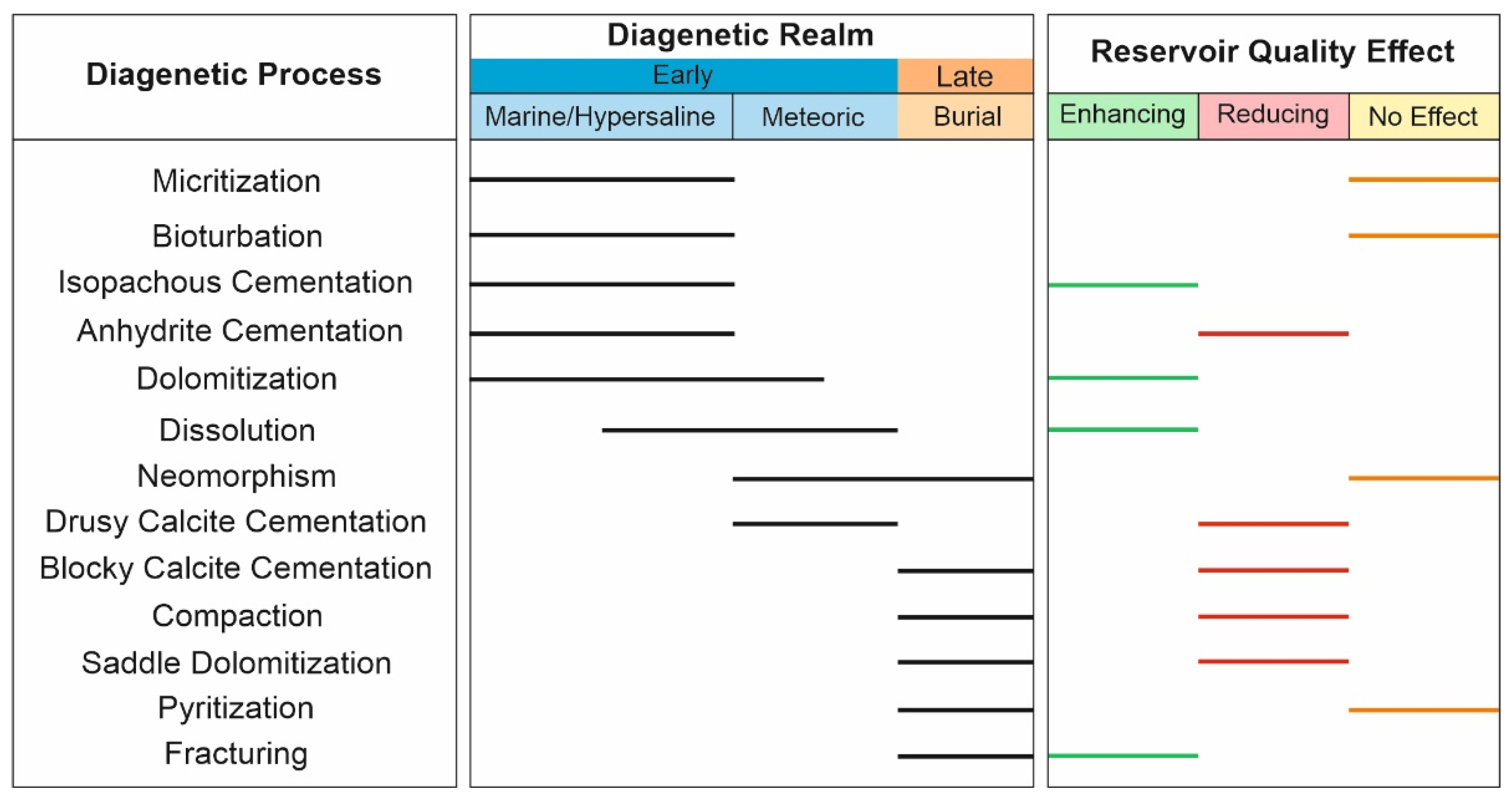
| Microfacies Code | Microfacies Name | Depositional Setting |
|---|---|---|
| FG1 | Anhydrite | Supratidal |
| FG2 | Dolomudstone/fenestral-nodular dolomudstone/dolo-breccia | Intertidal |
| FG3 | Stromatolite boundstone | Intertidal |
| FG4 | Thrombolite boundstone | Intertidal |
| FG5 | Bioturbated benthic foraminifera bioclast peloid mudstone/wackestone | Lagoon |
| FG6 | Bioclast intraclast ooid wackestone | Lagoon |
| FG7 | Intraclast oncoid wackestone | Lagoon |
| FG8 | Peloid oncoid packstone | Shoal |
| FG9 | Bioclast ooid packstone/grainstone | Shoal |
| FG10 | Oncoid intraclast packstone/grainstone | Shoal |
| FG11 | Microbioclast mudstone/wackestone | Off-shoal |
| FG12 | Crystalline carbonate | Not recognizable |
| HFU | Geological Properties | Petrophysical Properties | Reservoir Quality | ||||
|---|---|---|---|---|---|---|---|
| Dominant Facies | Dominant Diagenesis | Mean K | Mean Phi | Mean RQI | Mean FZI | ||
| 1 | FG1, FG3, FG4 | Compaction, Anhydrite Cementation | 0.00 | 1.52 | 0.02 | 1.03 | Worst |
| 2 | FG5, FG6, FG7 | Compaction, Cementation | 0.05 | 28.92 | 0.01 | 0.03 | Poor |
| 3 | FG2, FG7, FG11 | Dolomitization, Fracturing | 0.11 | 23.32 | 0.02 | 0.07 | Poor–Fair |
| 4 | FG8, FG11, FG12 | Dolomitization, Fracturing | 0.22 | 15.75 | 0.04 | 0.19 | Fair |
| 5 | FG8, FG9, FG10 | Dissolution | 0.80 | 11.50 | 0.08 | 0.62 | Fair–Good |
| 6 | FG9, FG10 | Dissolution | 3.96 | 8.66 | 0.21 | 2.12 | Good |
| 7 | FG9 | Dissolution, Fracturing | 15.66 | 6.10 | 0.50 | 7.24 | Best |
| 8 | FG9, FG10 | Dissolution, Dolomitization | 5.71 | 1.39 | 0.64 | 44.78 | Good |
| Reservoir Zone | Formation | Unit | Mean Values | Sum Values | Type | |||
|---|---|---|---|---|---|---|---|---|
| K | Phi | RPS | PhiH% | KH% | ||||
| Zone 1 | Kangan | K1 | 0.96 | 2.05 | 127.26 | 1.98 | 0.12 | Br/Bf |
| Zone 2 | Kangan | K1 | 55.87 | 12.06 | 315.23 | 2.06 | 0.63 | Rs |
| Zone 3 | Kangan | K1 | 1196.15 | 21.91 | 4810.66 | 9.65 | 52.81 | Bf/Rs |
| Zone 4 | Kangan | K1 | 10.50 | 12.16 | 61.12 | 3.55 | 0.47 | Bf |
| Zone 5 | Kangan | K1 | 0.22 | 1.73 | 17.50 | 1.36 | 0.02 | Br |
| Zone 6 | Kangan | K2 | 4.07 | 6.79 | 36.03 | 1.46 | 0.07 | Br/Bf |
| Zone 7 | Kangan | K2 | 1202.56 | 19.90 | 4280.08 | 5.58 | 35.07 | Rs |
| Zone 8 | Kangan | K2 | 2.96 | 7.83 | 30.87 | 3.30 | 0.15 | Br/Bf |
| Zone 9 | Kangan | K2 | 0.02 | 3.14 | 1.89 | 0.57 | 0.00 | Br |
| Zone 10 | U. Dalan | K3 | 57.63 | 15.00 | 236.68 | 5.43 | 2.44 | Bf/Rs |
| Zone 11 | U. Dalan | K3 | 6.12 | 7.16 | 112.98 | 4.63 | 0.37 | Br/Bf |
| Zone 12 | U. Dalan | K3 | 0.37 | 4.58 | 12.68 | 0.75 | 0.01 | Br |
| Zone 13 | U. Dalan | K3 | 3.44 | 10.31 | 35.90 | 6.02 | 0.23 | Br/Bf |
| Zone 14 | U. Dalan | K3 | 2.35 | 2.71 | 133.33 | 2.06 | 0.22 | Br |
| Zone 15 | U. Dalan | K3 | 7.88 | 10.94 | 57.00 | 2.40 | 0.23 | Bf |
| Zone 16 | U. Dalan | K4 | 31.83 | 16.87 | 145.47 | 9.84 | 2.03 | Bf/Rs |
| Zone 17 | U. Dalan | K4 | 15.39 | 22.65 | 69.34 | 23.35 | 1.92 | Rs |
| Zone 18 | U. Dalan | K4 | 10.91 | 16.53 | 49.16 | 12.34 | 0.96 | Bf/Rs |
| Zone 19 | U. Dalan | K4 | 44.84 | 9.22 | 271.29 | 3.67 | 2.26 | Bf |
Disclaimer/Publisher’s Note: The statements, opinions and data contained in all publications are solely those of the individual author(s) and contributor(s) and not of MDPI and/or the editor(s). MDPI and/or the editor(s) disclaim responsibility for any injury to people or property resulting from any ideas, methods, instructions or products referred to in the content. |
© 2025 by the authors. Licensee MDPI, Basel, Switzerland. This article is an open access article distributed under the terms and conditions of the Creative Commons Attribution (CC BY) license (https://creativecommons.org/licenses/by/4.0/).
Share and Cite
Mehrabi, H.; Ghoreyshi, S.S.; Hezarkhani, Y.; Rostami, K. Diagenetic Classification—A New Concept in the Characterization of Heterogeneous Carbonate Reservoirs: Permian–Triassic Successions in the Persian Gulf. Minerals 2025, 15, 690. https://doi.org/10.3390/min15070690
Mehrabi H, Ghoreyshi SS, Hezarkhani Y, Rostami K. Diagenetic Classification—A New Concept in the Characterization of Heterogeneous Carbonate Reservoirs: Permian–Triassic Successions in the Persian Gulf. Minerals. 2025; 15(7):690. https://doi.org/10.3390/min15070690
Chicago/Turabian StyleMehrabi, Hamzeh, Saghar Sadat Ghoreyshi, Yasaman Hezarkhani, and Kulthum Rostami. 2025. "Diagenetic Classification—A New Concept in the Characterization of Heterogeneous Carbonate Reservoirs: Permian–Triassic Successions in the Persian Gulf" Minerals 15, no. 7: 690. https://doi.org/10.3390/min15070690
APA StyleMehrabi, H., Ghoreyshi, S. S., Hezarkhani, Y., & Rostami, K. (2025). Diagenetic Classification—A New Concept in the Characterization of Heterogeneous Carbonate Reservoirs: Permian–Triassic Successions in the Persian Gulf. Minerals, 15(7), 690. https://doi.org/10.3390/min15070690









